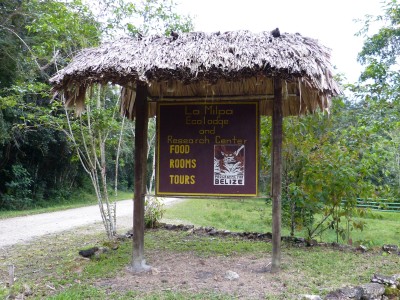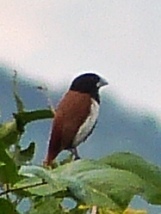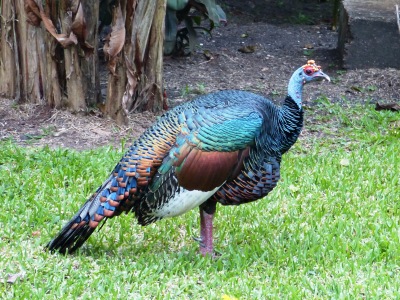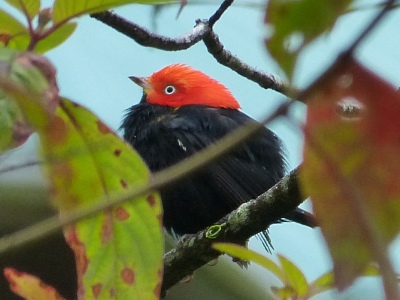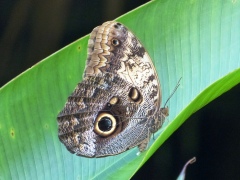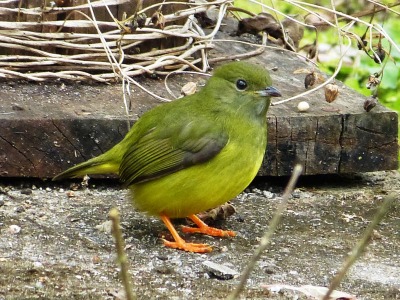La Milpa Ecolodge and Research Center is about 70 miles north of duPlooy’s Jungle Lodge. Maps show a road going directly between the two locations. However, locals warned us to not even think about it as the road was impossible to drive, especially after all the recent rain. So, we headed east and slightly north on the Western Highway, north a short distance on the Burrell Boom cut-off, north-northwest on the Northern Highway to Orange Walk town, and finally southwest to La Milpa. Yes, we pretty much drove in a circle to get just a little north of where we started out. Thus, the 70-miles distance became much more and took most of a day to travel. However, Jeremy and I enjoyed the drive and found some interesting birds on the way.
The first life bird on the day’s journey was mine, a Northern Jacana. Next, it was Jeremy’s turn with a very cooperative female Snail Kite. The kite flew around a little pond, actively foraging for snails. What a treat to see a bird demonstrating the trait for which it is named. The next new bird was a real puzzler. We both knew that we had never seen it before and neither of us had any idea what it was. And, it just was not in our book, Birds of Belize. There was a flock of about a dozen of them in the tall weeds on the edge of a ditch by a rice field. Jeremy and I both got photos and later someone was able to identify the birds as Tricolored Munia. Have you guessed the rest of the story? It is a non-native introduced species, probably established from escaped caged birds, and it is spreading rapidly in Central America and Mexico. Like many exotic species, it is feared that they may become troublesome, especially as agricultural pests.
We arrived at La Milpa at 3:30 PM and immediately liked the research station which is operated by the Programme for Belize, a non-profit organization focused on conservation. This was different from any other place we had stayed in Belize. Security had been obvious at all the resorts. At Jungle Jeanie, they even had dogs to accompany the security guards on their rounds. Everyone had said that Belize is very safe and they just want to keep it that way. However, at La Milpa there were no guards and not even keys to the rooms! One guest who had apparently stayed there many times said, “I’ve never seen a key here.” The atmosphere was very casual and academic. A group of botany professors and students from the Royal Botanic Garden, Edinburgh, Scotland, filled most of the rooms. Meals added to the feeling of being back in school with buffet style serving, shared tables, and returning our own dishes to the kitchen. If you wanted a beer or soda, you just helped yourself by taking one from the refrigerator and writing your name in a log book.
The guide who had been recommended to us was not available, so Jeremy and I were really on our own with birding at La Milpa, but I still added nine birds to my life list. The first afternoon I was thrilled to see two Great Currasows at the edge of the woods and an Ocellated Turkey up close (both lifers) as well as a Keel-billed Toucan and both Red-capped and White-collared Manakins. On Wednesday, we explored the nearby La Milpa Maya site, the third largest in Belize. La Milpa has not been uncovered or reconstructed and I found it difficult to imagine what it was like 1200 years ago. The most interesting description of the site that I have found is by a young man who was a volunteer in 2010 with the Field School program administered by the University of Texas, Field Notes From a Maya Ruin. It was not as birdy as we had expected, but we enjoyed walking the jungle trails and seeing a gorgeous Black-throated Shrike-Tanager, a life bird for both Jeremy and me.
Back at the field station, jungle life right on the grounds delighted us. Red-capped Manakins seemed to be everywhere, a huge owl butterfly flew into a building and was later rescued, Red Foxes cried on the walkways. And, there was the “magic tree,” perhaps a type of fig. You could watch this small tree for hours and keep seeing new birds as they came to feast on the small fruits. The weedy areas around the edges attracted birds, too, including one of our new favorites, the brilliant Blue Bunting. There were very few artificial feeders at La Milpa, but careful planting of native fruit-bearing trees and shrubs brought the birds in close to the buildings and walkways.
All too soon, it was our last morning in Belize. We had breakfast at La Milpa, birded for an hour, and then started towards the airport. We saw one more trip bird and a lifer for Jeremy, a Bronzed Cowbird, on our leisurely drive to Belize City. The entire 12-day trip (January 11-23, 2014) was wonderful and I look forward to my next visit to Belize.
